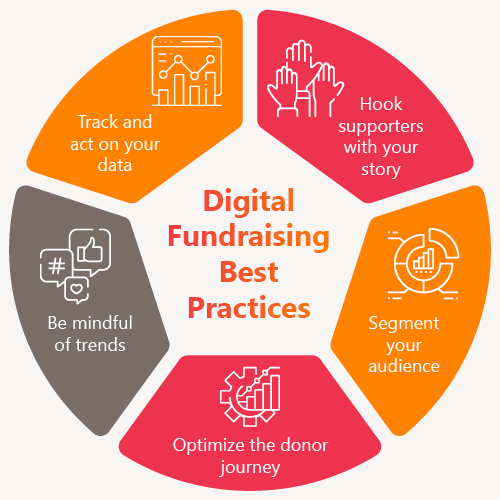Nonprofit Agency: Specialist Providers to Assistance Your Goal and Goals
Nonprofit Agency: Specialist Providers to Assistance Your Goal and Goals
Blog Article
The Duty of Neighborhood Interaction in Nonprofit Fundraising: Building Lasting Relationships for Lasting Support
Community involvement is significantly recognized as a crucial component of successful not-for-profit fundraising. By promoting genuine connections with local stakeholders, organizations can grow depend on and commitment, which are necessary for sustainable assistance. However, the approaches and techniques employed to engage neighborhoods differ widely, elevating vital inquiries regarding performance and influence. What are the very best techniques for cultivating these crucial connections, and exactly how can nonprofits gauge their success in this arena? Comprehending these characteristics could substantially affect the future of fundraising efforts and the general goal of not-for-profit organizations.
Recognizing Community Interaction
Area interaction is a vital part of successful nonprofit fundraising initiatives. Nonprofits should identify crucial stakeholders-- such as neighborhood participants, regional businesses, and various other organizations-- to develop efficient engagement methods.
Effective area interaction is predicated on energetic listening and responsiveness to the needs and passions of the neighborhood. This procedure involves obtaining comments, recognizing neighborhood characteristics, and making sure that the organization's objective straightens with regional top priorities. Engaging the neighborhood can take various types, consisting of public meetings, volunteer chances, and partnership initiatives, each developed to urge participation and financial investment in the organization's objectives.
Furthermore, neighborhood engagement should be come close to as an ongoing dialogue instead than a single effort. By promoting a comprehensive setting where community voices are heard and valued, nonprofits can develop a solid foundation for future fundraising ventures. Eventually, a deep understanding of area engagement equips companies to develop genuine links that enhance their overall efficiency and sustainability.
Benefits of Solid Relationships
Solid partnerships created through community engagement return various benefits for nonprofit fundraising initiatives. Most importantly, these partnerships foster trust fund and integrity, essential components in encouraging donors to contribute. When potential supporters see a nonprofit proactively associated with their neighborhood, they are more probable to rely on its objective and effect.

In addition, these connections promote efficient interaction. Nonprofits can take advantage of their links to share stories of influence, updates, and needs, ensuring that advocates remain educated and engaged. This open line of communication not just strengthens bonds yet also motivates word-of-mouth promo, expanding the not-for-profit's reach.
Finally, solid community ties can bring in new partners and enrollers. Businesses and individuals are much more likely to align with companies that show significant area involvement, supplying added resources and support that can dramatically enhance fundraising abilities. Hence, growing robust connections with area involvement is important to a nonprofit's long-term fundraising success.
Strategies for Effective Interaction
Just how can nonprofits effectively engage their neighborhoods to enhance fundraising initiatives? Creating targeted strategies is necessary for cultivating meaningful links. First, leveraging social media systems enables organizations to share their objective dynamically and interactively, getting to a broader target market. Regular updates, engaging material, and calls-to-action can galvanize community rate of interest and involvement.
2nd, holding community events, such as workshops, volunteer opportunities, or fundraising drives, assists in in person interaction, allowing nonprofits to display their influence and efforts. These events not just elevate funds yet likewise cultivate partnerships and enable area members to engage directly with the cause.
Third, carrying out customized interaction approaches can improve interaction. Tailoring messages to details donor sectors based upon passions and previous payments promotes a feeling of belonging and investment in the company's mission.
Lastly, producing collaborations with local organizations and area leaders can enhance outreach initiatives. Collaborative efforts can enhance presence and integrity, showing a collective commitment to the neighborhood's health. By integrating these methods, nonprofits can develop lasting relationships that enhance fundraising initiatives and drive lasting support.
Determining Involvement Success
While engaging the community is important for successful not-for-profit fundraising, gauging the performance of these engagement initiatives is similarly important. Establishing clear metrics enables companies to evaluate just how well they are connecting with their audience and attaining their fundraising goals. Key performance indications (KPIs) such as donor retention rates, volunteer involvement levels, and involvement on social media platforms offer substantial data for examination.

Routinely evaluating these metrics allows companies to pivot their site techniques when needed, making sure that neighborhood interaction remains straightened with their overall objective. Furthermore, sharing these outcomes you can check here with stakeholders fosters transparency and builds trust, urging more area involvement. Eventually, a durable dimension structure not just notifies future fundraising initiatives yet also strengthens the connection between the nonprofit and its advocates, preparing for lasting success.
Study in Area Impact
Various study highlight the profound effect that area engagement can have on not-for-profit fundraising success. One notable example is the "Something to chew on" campaign, where a local food bank partnered with colleges and businesses to host community dinners. These occasions not just elevated funds but also promoted a sense of belonging amongst individuals, considerably boosting benefactor retention prices.
One more compelling situation is the "Eco-friendly Spaces Task," which entailed neighborhood homeowners in the revitalization of city parks. This campaign not just amassed economic assistance from neighborhood organizations yet additionally grew a volunteer base that added to continuous maintenance and programs. The feeling of possession and satisfaction amongst community participants equated right into continual payments.
In the realm of arts, the "Art for All" campaign effectively engaged local artists and customers to produce collective art setups, resulting in boosted visibility and contributions for a regional arts nonprofit.
These examples highlight that when nonprofits focus on community involvement, they can create lasting partnerships that improve fundraising efforts, guaranteeing lasting assistance and promoting a vibrant area society. Such cases show that area interaction is not merely an approach however a crucial column of nonprofit success.
Conclusion
To conclude, area interaction is essential to the success of nonprofit fundraising initiatives. By promoting strong relationships with local stakeholders, companies improve count on and integrity, resulting in improved contributor retention and commitment. Executing reliable interaction strategies and determining their impact makes sure that nonprofits can adapt and prosper. Inevitably, a robust structure of community assistance not only intensifies fundraising potential yet likewise cultivates a society of cooperation, essential for accomplishing long-term business objectives and sustaining purposeful effect.
Nonprofits have to recognize key stakeholders-- such as neighborhood members, neighborhood organizations, and other companies-- to develop effective interaction methods.

In conclusion, area interaction is integral to the success of nonprofit fundraising initiatives.
Report this page